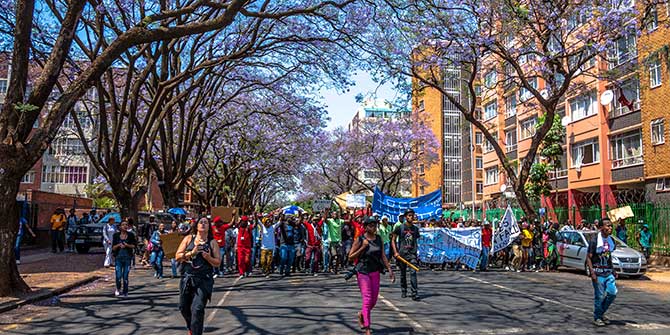Rhian Keyse recommends this book as essential reading for scholars and practitioners engaging in work to analyse and intervene in gender-based violence on the African continent and elsewhere.
Forced marriage in sub-Saharan Africa is a source of much international debate, especially with recent legal and policy attention to the role of such practices in conflict situations. Well-reported instances such as the abduction of the ‘Chibok girls’ from their school in north-eastern Nigeria in 2014 have prompted considerable attention from the popular media and policy advocates alike. Yet, as Annie Bunting, Benjamin Lawrance and Richard Roberts argue in the introduction to Marriage by Force?, ‘the spectacular hides the mundane’, and popular debates tend to oversimplify the complex range of practices referred to as ‘forced marriage’ (p.2). Based on a 2013 conference at the Rochester Institute of Technology, this book brings together anthropologists, legal scholars, historians, and practitioners, to begin to correct these reductive common narratives.
This volume makes a number of vital contributions to our understanding of forced marriage. This review will focus on two of the themes that are most prominent throughout the volume, and which provide perhaps the most useful general insights for scholars and practitioners. Firstly, the book demonstrates that context is key. Coercion and consent in marriage are complex, varying with time and place. As Richard Roberts reminds us, debates over forced marriage ‘have a longer history and are related to the complex interactions between African societies and colonial societies in Africa’ (p.43). Scholars and practitioners must therefore place their analyses within the appropriate historical, social, cultural, economic, and legal milieus, to gain a fuller understanding of forced marriage. The chapters by Ojo, Roberts, Shadle and Declich examine colonial approaches to coercive marriage practices, drawing on examples from French, British, and Italian imperial contexts. These chapters demonstrate that colonial policies were not static, but shifted with changing sensibilities about childhood, ideas of governance and civilisation, and social realities. In certain times and places, as Roberts, Shadle, and Ojo show, forced marriage was the subject of colonial discussion and sometimes intervention. Elsewhere, colonial policy shored up coercive marital practices to maintain social order, while, as Declich shows, in Somaliland, African women and girls were forced into monogamous unions as an explicit part of Italian colonial policy. Hynd’s chapter on the relationship between child soldiering and forced marriage also reminds us of the need to consider longer histories and wider contexts, arguing that forced marriage in conflict results from structural patterns of gender-based violence (p.302).
The second key theme arising from the book is that of the limitations of legal interventions – on the international, national, and local levels. Thornberry and Saho, in their chapters on South Africa and the Gambia respectively, examine the persistent uses – and contested nature – of concepts like ‘culture’ and ‘tradition’ in justifying forcible marriages, even where legislative frameworks exist seeking to curtail these practices. In a timely chapter, given public attention to forced migration, Lawrance and Walker-Said argue that the rigid nature of international conventions and domestic asylum regimes, which do not include gender as a social category requiring protection, force claimants to ‘reformulate’ their narratives to make them acceptable to adjudicators and judges (p.201). Ferme also critiques international structures, convincingly arguing that prosecutors’ strategies in establishing forced marriage in conflict as a crime against humanity draws artificial distinctions between coercive conjugal practices in wartime and in peace. Both of these chapters highlight the ways that lived experiences and societal structures contributing to domestic violence are obstructed by making stories about forced marriage fit with legal structures. Walker and Mukenge also take on the issue of international norms, reminding us of the complex relationship between international rights regimes and local realities, which should not be oversimplified. Mukenge in particular provides an important reminder of local advocacy, which often gets ignored by international-level debates, arguing that community initiatives must be integrated into global campaigns. These chapters all demonstrate the limits of legislation and conventions – at the international, national, and local levels – in providing effective recourse in cases of forced marriage.

Photo credit: World Bank Photo Collection via Flickr (http://bit.ly/2vO34Yn) CC BY-NC-ND 2.0
Emily Burrill’s Afterword is also worthy of particular mention, skilfully bringing together the arguments in this volume, by stressing the need for a longue durée perspective on forced marriage, which focuses on these practices as structural rather than sensational or isolated. Crucially, she calls for the responsible examination of traumatic experiences such as forced marriage as a form of ‘scholarly social justice’ (p.313).
The volume succeeds in providing an important interdisciplinary corrective to the over-generalised and reductive presentations of forced marriage which dominate popular discussions. The editors also point to potentially fruitful new research avenues, such as linking studies of forced marriage in Africa with those in diaspora communities, and engaging in comparative work on coercive marriage practices in Asia and Africa (p.34). One minor shortcoming, however, is that although the chapters demonstrate the complex interplay between international, national, and local debates and interventions, there is perhaps not enough attention to the ways in which these international norms developed, and in particular how African marital practices were central to the debates which helped to frame these.
Nonetheless, this volume, dealing with one of the ‘more critical human rights challenges in twenty-first century sub-Saharan Africa’, is a timely and useful contribution to a broader literature which seeks to place gender-based violence into historical, social, and cultural context (p.28). It ought to be essential reading for scholars and practitioners engaging in work to analyse and intervene in gender-based violence on the African continent and elsewhere.
Marriage by Force?: Contestation over Consent and Coercion in Africa. Annie Bunting, Benjamin N. Lawrance, and Richard L. Roberts (eds.). Ohio University Press. 2016
Rhian Keyse is a PhD candidate at the Centre for Imperial and Global History at the University of Exeter. She is also an experienced practitioner and activist in the gender-based-violence sector.
The views expressed in this post are those of the author and in no way reflect those of the Africa at LSE blog or the London School of Economics and Political Science.





